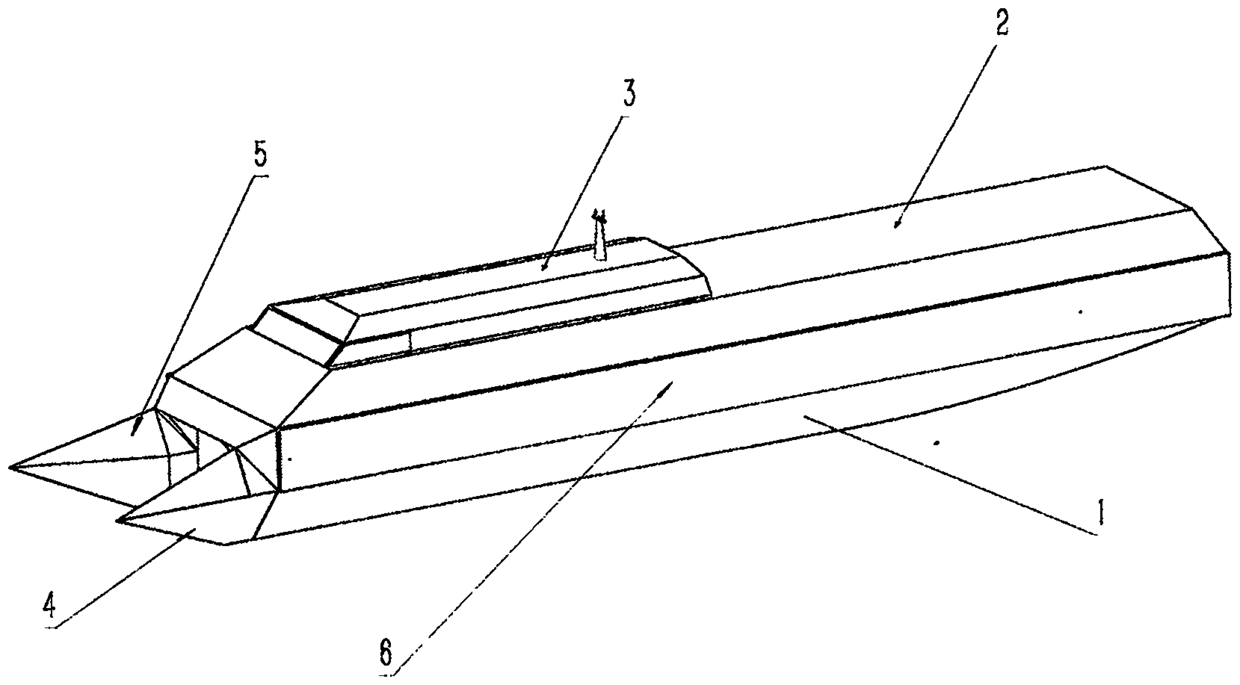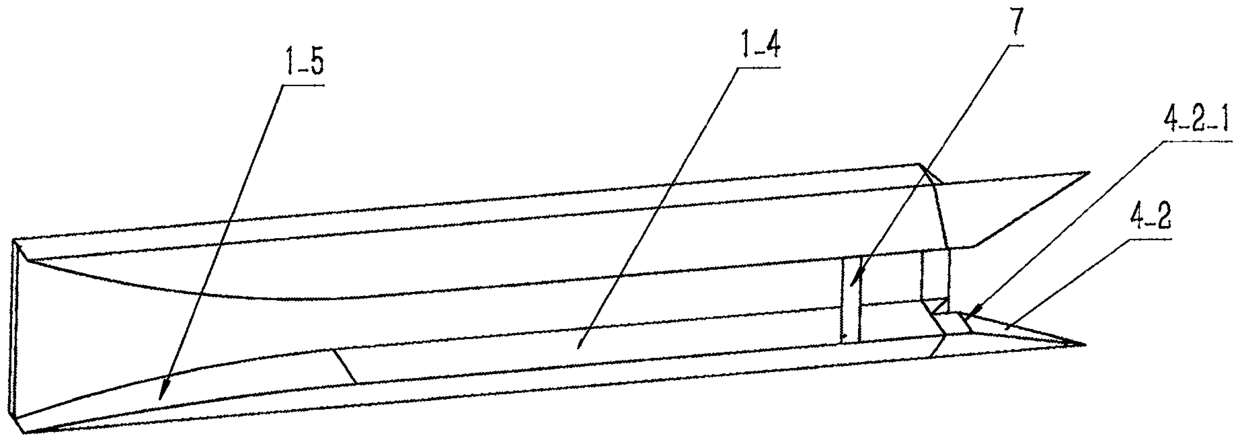A low energy consumption catamaran structure
A catamaran, low energy consumption technology, applied in the field of ships to achieve the effect of increasing sailing speed, increasing water pressure and enhancing propulsion
- Summary
- Abstract
- Description
- Claims
- Application Information
AI Technical Summary
Problems solved by technology
Method used
Image
Examples
Embodiment 1
[0024] The two hulls 1 of the low-energy catamaran described in the present invention and the tip diverters 4 of the two bows are all straight plates on the outside.
[0025] The two hulls 1 of a low-energy catamaran described in the present invention are symmetrical to the longitudinal vertical center plane of the total hull; The inner inclined straight board 1-3, and the outer two vertical straight boards 1-1 are parallel to each other.
[0026] The bows of the two hulls 1 are all arranged as triangular cone-shaped tip water diversion heads 4, and the outer triangular surface 4-1 is on the same plane as the straight plate 1-3 on the outside of the hull that is inclined to the inner side of the ship bottom.
[0027] The two hulls 1 of the low-energy catamaran and the tip diverters 4 of the two bows are all straight plates on the outside, and its effect is that when the catamaran is sailing forward, the hull does not discharge water to the outside of the two sides of the hull....
Embodiment 2
[0029] The inner sides of the two hulls 1 of the low-energy catamaran structure of the present invention are vertical straight plates 1-4 and smooth curved plates 1-5, and the inner triangular surface 4-2 of the tip diverter 4 of the bow is vertical. Straight inward sloped setting.
[0030] On the inside of the hull of the two hulls 1, the main body part of the hull is set as a vertical straight plate 1-4, and the stern part is set as a smooth curved plate 1-5 that is vertical but curved to the outside of the tail of the hull.
[0031] The bows of the two hulls 1 are all set to a triangular cone-shaped tip water diversion head 4, the inner triangular surface 4-2 is vertical but inclined to the center of the hull to the stern, and the bottom edge 4-2- of the triangular surface 4-2 1 is seamlessly connected with the vertical straight plate 1-4 on the inside of the hull.
[0032] The shape of the inside of the hull of the two hulls 1 of the low-energy catamaran is set and the sh...
Embodiment 3
[0034] The two bows of the two hulls 1 of the low-energy catamaran structure described in the present invention are all set as tip water diversion heads 4, and the sharp angle 4-4 of each tip water diversion head 4 is 19.5°. The bottom frame between the two hulls 1 is provided with a horizontally placed turbulence guide plate 7 .
[0035] The two bows of the low-energy catamaran structure are tip subheads 4, and the forward sharp angle 4-4 of the horizontal triangular plane 4-3 at the upper end of each tip subhead 4 is set to 19.5°. It is the turbulent flow and v-shaped ship traveling waves generated after the water is drained from the inner triangular surface 4-2 of the tip water diversion head 4, which can be assembled and superimposed to form the largest wave crest.
[0036] The bottom frame between the two hulls 1 of the low-energy catamaran is provided with a horizontally placed turbulence deflector 7, the front edge of the turbulence deflector 7 is in the longitudinal di...
PUM
 Login to View More
Login to View More Abstract
Description
Claims
Application Information
 Login to View More
Login to View More - R&D
- Intellectual Property
- Life Sciences
- Materials
- Tech Scout
- Unparalleled Data Quality
- Higher Quality Content
- 60% Fewer Hallucinations
Browse by: Latest US Patents, China's latest patents, Technical Efficacy Thesaurus, Application Domain, Technology Topic, Popular Technical Reports.
© 2025 PatSnap. All rights reserved.Legal|Privacy policy|Modern Slavery Act Transparency Statement|Sitemap|About US| Contact US: help@patsnap.com



